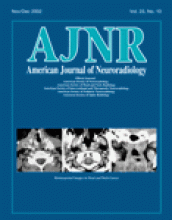Abstract
BACKGROUND AND PURPOSE: A reduction in the area of the substantia nigra (SN) has been shown in patients with Parkinson disease. The substantia nigra is anteroinferolateral to the red nucleus, and it is important to precisely locate its true anatomic location to accurately measure SN area. Our purpose was to determine the exact location of the substantia nigra by correlating imaging and anatomic findings. We also attempted to quantitate SN area in patients with Parkinson disease compared with that in healthy control subjects on the basis of proton density-weighted spin-echo (SE) and fast short inversion time inversion-recovery (STIR) MR imaging findings.
METHODS: In four healthy volunteers, dual-echo SE and fast STIR MR images were obtained in three orthogonal planes and an oblique coronal plane. These images were correlated with anatomic specimens to determine the location of the SN. The area of the SN was also measured on oblique coronal fast STIR images obtained at a plane perpendicular to the SN in 22 patients with Parkinson disease and in 22 age- and sex-matched healthy volunteers.
RESULTS: The true anatomic location of the SN, anteroinferolateral to the red nucleus, was accurately identified, not on T2-weighted images, but on proton density-weighted SE images and fast STIR images as an area of hyperintense gray matter. The hypointense area seen on T2-weighted images corresponded to the anterosuperior aspect of the SN and to the adjacent crus cerebri. No statistically significant differences were noted in the size of the SN when the oblique coronal images of patients with Parkinson disease were compared with those of the control groups.
CONCLUSION: The SN is located mainly beneath the red nucleus. Its location cannot be determined on the basis of T2-weighted imaging results but rather on the basis of proton density-weighted SE or fast STIR findings. SN volume loss is not found in Parkinson disease, and this finding is compatible with that of recent pathology reports in the literature.
- Copyright © American Society of Neuroradiology












